Multi-Utility Solar Thermal Systems: Harnessing Parabolic Trough Concentrator Using SAM Software for Diverse Industrial and Residential Applications
Abstract
1. Introduction
- -
- Conduct a detailed evaluation of the thermal and electrical performance of PTC-based solar thermal systems using SAM software.
- -
- Simulate the operation of PTC systems under specific climatic conditions to determine their efficiency and output.
- -
- Analyze the impact of different parameters such as solar irradiance, ambient temperature, and wind speed on system performance.
- -
- Investigate the thermal losses and overall energy conversion efficiency, providing a thorough assessment of the system’s potential in real-world applications.
- -
- Develop a robust simulation model within SAM software to accurately predict the behavior of PTC systems.
- -
- Integrate thermal storage options within the simulation to evaluate their impact on system performance and reliability.
- -
- Use the simulation results to generate performance maps and guidelines for designing and deploying PTC systems in various settings.
- -
- Identify key factors and design parameters that influence the performance and efficiency of PTC systems. This includes investigating—in the future—the impact of reflector materials, absorber coatings, tracking mechanisms, and thermal storage options.
- -
- Investigate the potential applications of PTC systems across different sectors, including residential, commercial, and industrial domains. (i) For residential applications, assess the feasibility of using PTC systems for water heating, space heating, and potentially cooling through absorption chillers. (ii) For industrial applications, explore the use of PTC systems for process heat, such as in food processing, chemical manufacturing, and textile production.
2. System Description
2.1. SAM Software
2.2. Weather Data for Kenitra Site
3. Parabolic Trough Concentrator Technology (PTC)
3.1. Physical Model for a PTC
3.2. Components for a PTSTPP
3.2.1. Solar Field
- is the horizontal beam radiation;
- is the zenith angle;
- is the incidence angle.
- Declination is the angular location of the sun relative to the equator plane. It depends on the day of the year
- Hour angle is the angular position of the sun relative to the local meridian. It changes by 15° per hour because of Earth’s rotation around its axis.
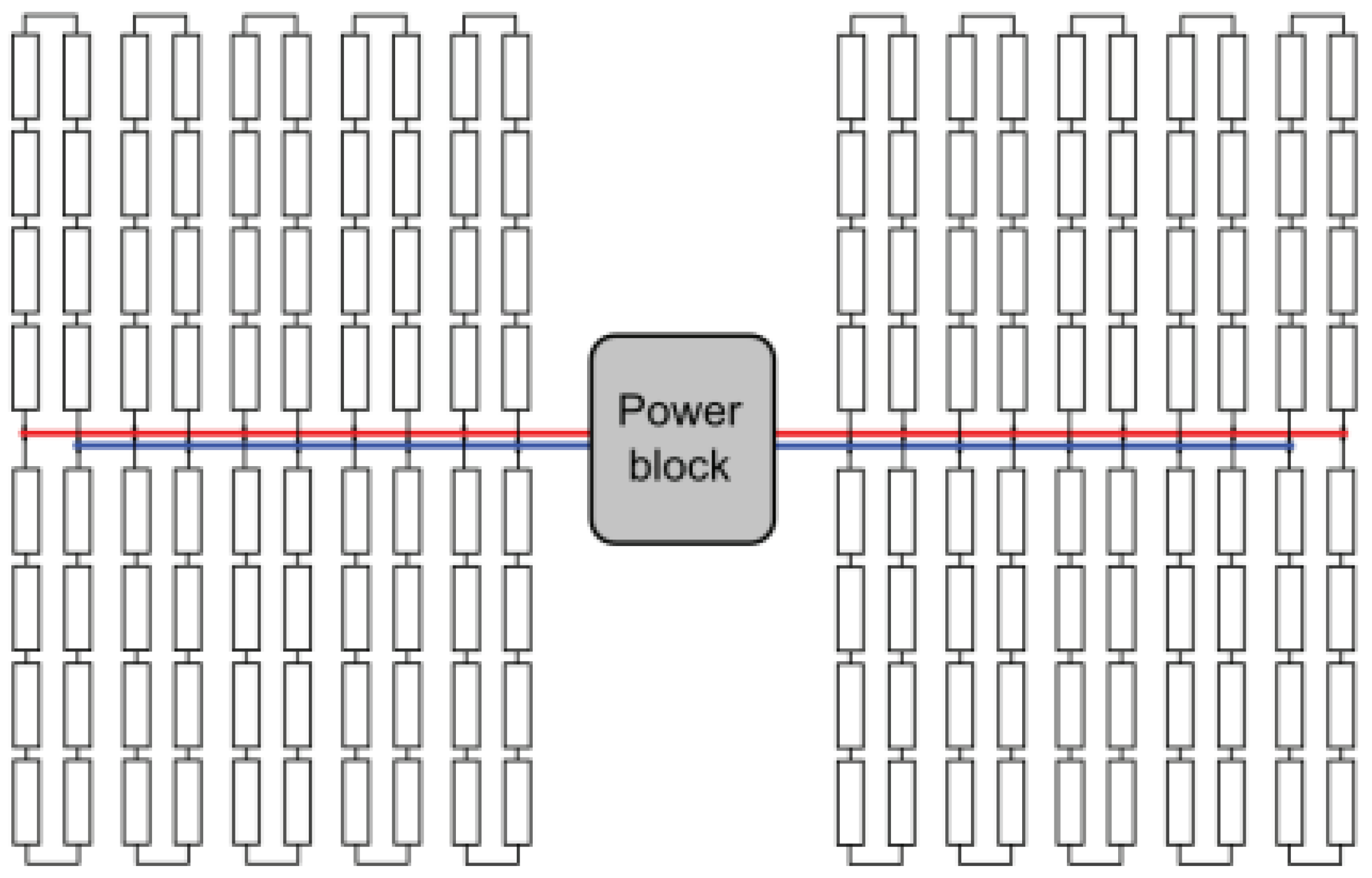
3.2.2. Power Cycle
- The Energy Balance for the Turbine (Work Output):
- 2.
- Pump Work Input:
- 3.
- Energy Balance for the Boiler (Heat Input):
- 4.
- Energy Balance for the Condenser (Heat Rejection):
- 5.
- The net work output:
- 6.
- Thermal Efficiency ():
3.2.3. Storage System
4. Results and Discussion
4.1. Electricity Production and Performance Analysis
4.2. Power and Thermal Losses
- Lower solar irradiance in January. Less solar energy input means less heat needs to be transported and less condenser operation is required.
- Cooler ambient temperatures in January. A reduced need for cooling leads to lower condenser power consumption.
- Both graphs show similar trends with peak parasitic losses occurring around midday.
- The July graph shows higher magnitudes for all parasitic losses compared with January. This aligns with the expected lower energy demand and reduced thermal losses in January.
5. Economic Analysis
6. Conclusions and Future Work
- ✓
- Therminol VP-1 as the heat transfer fluid (HTF). This fluid ensures efficient heat transfer, enhancing the overall thermal performance of the system.
- ✓
- Dry cooling system. This technology minimizes water consumption, which is essential in arid regions, thus improving the plant’s sustainability.
- ✓
- HITEC solar salt in the thermal energy storage (TES) system. This allows for efficient energy storage, enabling continuous power supply even during non-sunny periods.
Author Contributions
Funding
Data Availability Statement
Conflicts of Interest
Nomenclature
| direct normal radiation () | |
| the horizontal beam radiation () | |
| the zenith angle (degree) | |
| the incidence angle (degree) | |
| declination (degree) | |
| CF | capacity factor (%) |
| PTC | parabolic trough collector |
| RC | Rankine cycle |
| CSP | concentrated solar power |
| LCOE | levelized cost of electricity |
| DNI | direct normal irradiance |
| SAM | System Advisor Model |
| SF | solar field |
| SM | solar multiple |
| TES | thermal energy storage |
| TMY | typical meteorological year |
| NREL | National Renewable Energy Laboratory |
| RE | renewable energy |
| WF | working fluid |
| PC | power cycle |
| FBS | fuel backup system |
| HTF | heat transfer fluid |
| IAM | incidence angle modifier |
References
- Kousksou, T.; Allouhi, A.; Belattar, M.; Jamil, A.; El Rhafiki, T.; Arid, A.; Zeraouli, Y. Renewable energy potential and national policy directions for sustainable development in Morocco. Renew. Sustain. Energy Rev. 2015, 47, 46–57. [Google Scholar] [CrossRef]
- Ouarzazate NOOR I, II and III: 550 MW—SolarPaces. Available online: https://www.solarpaces.org/worldwide-csp/csp-potential-solar-thermal-energy-by-country/morocco/ (accessed on 6 April 2024).
- Morocco Advances Its Solar Energy Plan with Noor Midelt II Project—Marina Coronado. Available online: https://www.atalayar.com/en/articulo/economy-and-business/morocco-advances-its-solar-energy-plan-with-noor-midelt-ii-project/20230804113539189166.html (accessed on 6 April 2024).
- Boukelia, T.E.; Mecibah, M.S.; Kumar, B.N.; Reddy, K.S. Investigation of solar parabolic trough power plants with and without integrated TES (thermal energy storage) and FBS (fuel backup system) using thermic oil and solar salt. Energy 2015, 88, 292–303. [Google Scholar] [CrossRef]
- Bishoyi, D.; Sudhakar, K. Modeling and performance simulation of 100 MW PTC based solar thermal power plant in Udaipur India. Case Stud. Therm. Eng. 2017, 10, 216–226. [Google Scholar] [CrossRef]
- Benhadji Serradj, D.E.; Sebitosi, A.B.; Fadlallah, S.O. Design and performance analysis of a parabolic trough power plant under the climatological conditions of Tamanrasset, Algeria. Int. J. Environ. Sci. Technol. 2022, 19, 3359–3376. [Google Scholar] [CrossRef] [PubMed]
- Trabelsi, S.E.; Qoaider, L.; Guizani, A. Investigation of using molten salt as heat transfer fluid for dry cooled solar parabolic trough power plants under desert conditions. Energy Convers. Manag. 2018, 156, 253–263. [Google Scholar] [CrossRef]
- Ezeanya, E.K.; Massiha, G.H.; Simon, W.E.; Raush, J.R.; Chambers, T.L. System advisor model (SAM) simulation modelling of a concentrating solar thermal power plant with comparison to actual performance data. Cogent Eng. 2018, 5, 1524051. [Google Scholar] [CrossRef]
- Lopes, T.; Fasquelle, T.; Silva, H.G. Pressure drops, heat transfer coefficient, costs and power block design for direct storage parabolic trough power plants running molten salts. Renew. Energy 2021, 163, 530–543. [Google Scholar] [CrossRef]
- Yuanjing, W.; Cheng, Z.; Yanping, Z.; Xiaohong, H. Performance analysis of an improved 30 MW parabolic trough solar thermal power plant. Energy 2020, 213, 118862. [Google Scholar] [CrossRef]
- Bashir, A.A.A.; Özbey, M. Modelling and analysis of an 80-MW parabolic trough concentrated solar power plant in Sudan. Clean Energy 2022, 6, 512–527. [Google Scholar] [CrossRef]
- Aly, A.; Bernardos, A.; Fernandez-Peruchena, C.M.; Jensen, S.S.; Pedersen, A.B. Is Concentrated Solar Power (CSP) a feasible option for Sub-Saharan Africa?: Investigating the techno-economic feasibility of CSP in Tanzania. Renew. Energy 2019, 135, 1224–1240. [Google Scholar] [CrossRef]
- Praveen, R.P.; Baseer, M.A.; Awan, A.B.; Zubair, M. Performance analysis and optimization of a parabolic trough solar power plant in the middle east region. Energies 2018, 11, 741. [Google Scholar] [CrossRef]
- Ait Lahoussine Ouali, H.; Alami Merrouni, A.; Chowdhury, S.; Techato, K.; Channumsin, S.; Ullah, N. Optimization and Techno-Economic Appraisal of Parabolic Trough Solar Power Plant under Different Scenarios: A Case Study of Morocco. Energies 2022, 15, 8485. [Google Scholar] [CrossRef]
- Blair, N.; Diorio, N.; Freeman, J.; Gilman, P.; Janzou, S.; Neises, T.; Wagner, M. System Advisor Model (SAM) General Description (Version 2017.9.5); No. NREL/ TP-6A20-70414; National Renewable Energy Lab (NREL): Golden, CO, USA, 2018. [Google Scholar] [CrossRef]
- Diorio, N.; Dobos, A.; Janzou, S. Economic Analysis Case Studies of Battery Energy Storage with SAM; No. NREL/TP-6A20-64987; National Renewable Energy Lab (NREL): Golden, CO, USA, 2015. [Google Scholar] [CrossRef]
- Sun, J.; Zhang, Z.; Wang, L.; Zhang, Z.; Wei, J. Comprehensive review of line-focus concentrating solar thermal technologies: Parabolic trough collector (PTC) vs linear Fresnel reflector (LFR). J. Therm. Sci. 2020, 29, 1097–1124. [Google Scholar] [CrossRef]
- Meng, X.-L.; Liu, C.-L.; Bai, X.-H.; Kong, D.-H.; Du, K. Improvement of the performance of parabolic trough solar concentrator using freeform optics and CPV/T design. AIMS Energy 2021, 9, 286–304. [Google Scholar] [CrossRef]
- Tagle-Salazar, P.D.; Nigam, K.D.P.; Rivera-Solorio, C.I. Parabolic trough solar collectors: A general overview of technology, industrial applications, energy market, modeling, and standards. Green Process. Synth. 2020, 9, 595–649. [Google Scholar] [CrossRef]
- Geyer, M.; Lüpfert, E.; Osuna, R.; Esteban, A.; Schiel, W.; Schweitzer, A.; Zarza, E.; Nava, P.; Langenkamp, J.; Mandelberg, E. EUROTROUGH-Parabolic trough collector developed for cost efficient solar power generation. In Proceedings of the 11th SolarPACES International Symposium on Concentrated Solar Power and Chemical Energy Technologies, Zurich, Switzerland, 4–6 September 2002; Volume 7. [Google Scholar]
- Kalogirou, S.A. A detailed thermal model of a parabolic trough collector receiver. Energy 2012, 48, 298–306. [Google Scholar] [CrossRef]
- Nuwayhid, R.Y.; Mrad, F.; Abu-Said, R.J.R.E. The realization of a simple solar tracking concentrator for university research applications. Renew. Energy 2001, 24, 207–222. [Google Scholar] [CrossRef]
- Duffie, J.A.; Beckman, W.A. Solar Engineering of Thermal Processes, 4th ed.; Wiley: New York, NY, USA, 2013; 928p. [Google Scholar]
- Giglio, A.; Lanzini, A.; Leone, P.; Rodríguez García, M.M.; Zarza Moya, E. Direct steam generation in parabolic-trough collectors: A review about the technology and a thermo-economic analysis of a hybrid system. Renew. Sustain. Energy Rev. 2017, 74, 453–473. [Google Scholar] [CrossRef]
- Giostri, A.; Binotti, M.; Silva, P.; MacChi, E.; Manzolini, G. Comparison of two linear collectors in solar thermal plants: Parabolic trough versus Fresnel. J. Sol. Energy Eng. 2013, 135, 011001. [Google Scholar] [CrossRef]
- Wagner, M.J.; Gilman, P. Technical Manual for the SAM Physical trough Model; No. NREL/TP-5500-51825; National Renewable Energy Lab (NREL): Golden, CO, USA, 2011. [Google Scholar] [CrossRef]
- McMahan, A.C. Design & Optimization of Organic Rankine Cycle Solar-Thermal Powerplants. Master’s Thesis, University of Wisconsin-Madison, Madison, WI, USA, 2006. Available online: https://minds.wisconsin.edu/handle/1793/7889 (accessed on 15 March 2024).
- Ouammi, A.; Zejli, D.; Dagdougui, H.; Benchrifa, R. Artificial neural network analysis of Moroccan solar potential. Renew. Sustain. Energy Rev. 2012, 16, 4876–4889. [Google Scholar] [CrossRef]
- Azouzoute, A.; Alami Merrouni, A.; Touili, S. Overview of the integration of CSP as an alternative energy source in the MENA region. Energy Strategy Rev. 2020, 29, 100493. [Google Scholar] [CrossRef]
- Short, W.; Packey, D.J.; Holt, T. A Manual for the Economic Evaluation of Energy Efficiency and Renewable Energy Technologies; No. NREL/TP-462-5173; National Renewable Energy Lab (NREL): Golden, CO, USA, 1995. [Google Scholar] [CrossRef]
- Aqachmar, Z.; Allouhi, A.; Jamil, A.; Gagouch, B.; Kousksou, T. Parabolic trough solar thermal power plant Noor I in Morocco. Energy 2019, 178, 572–584. [Google Scholar] [CrossRef]
- Bhuiyan, N.; Ullah, W.; Islam, R.; Ahmed, T.; Mohammad, N. Performance optimisation of parabolic trough solar thermal power plants—A case study in Bangladesh. Int. J. Sustain. Energy 2020, 39, 113–131. [Google Scholar] [CrossRef]
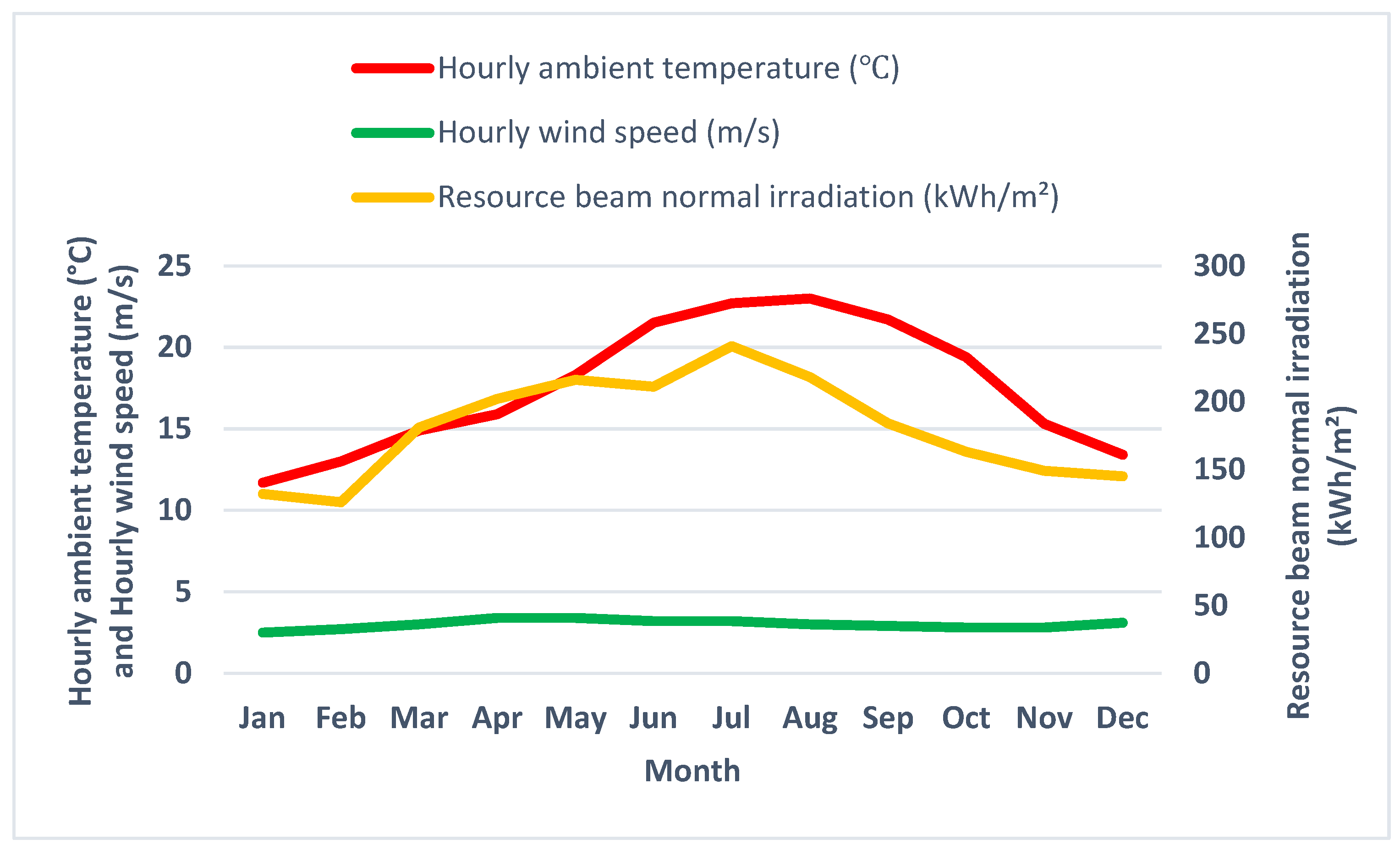

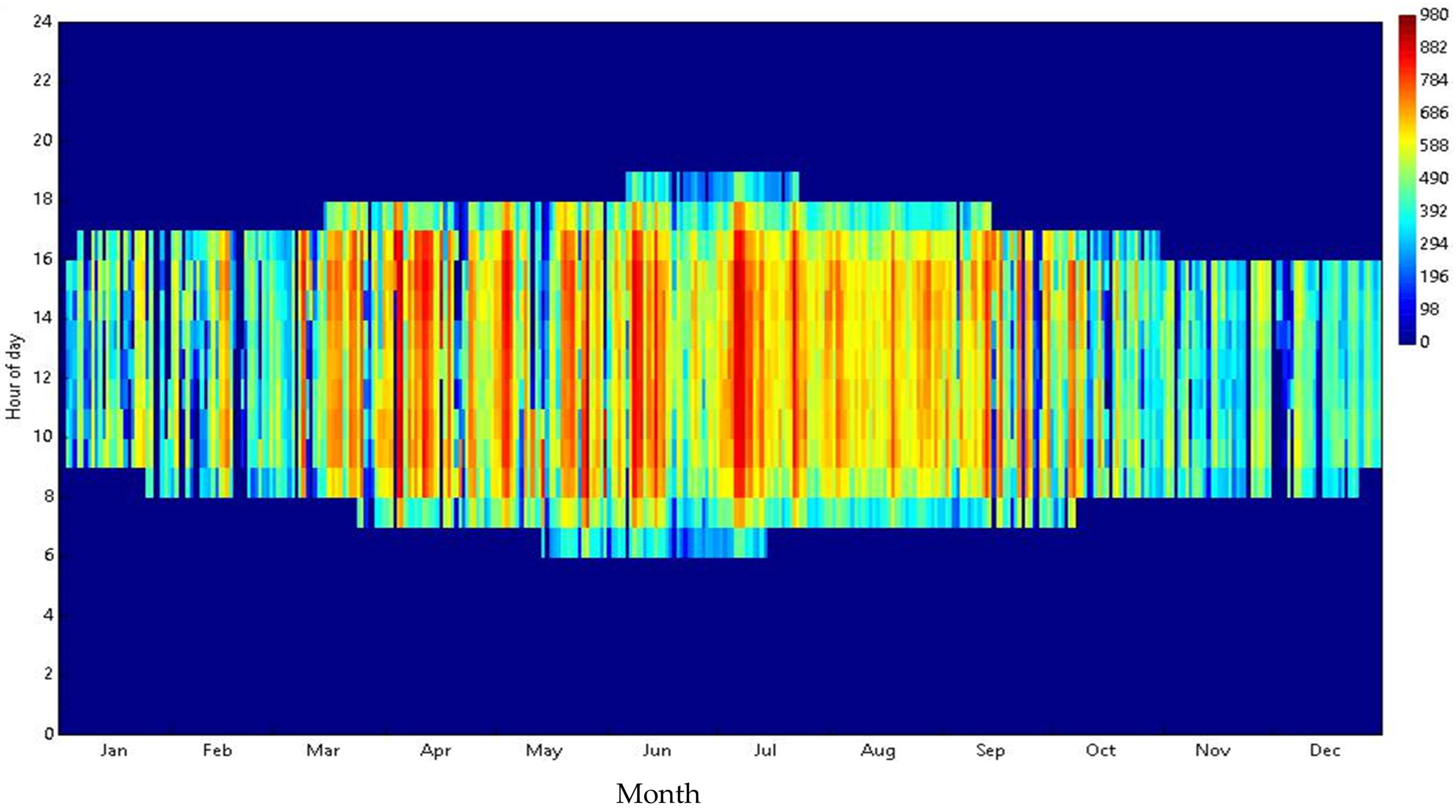
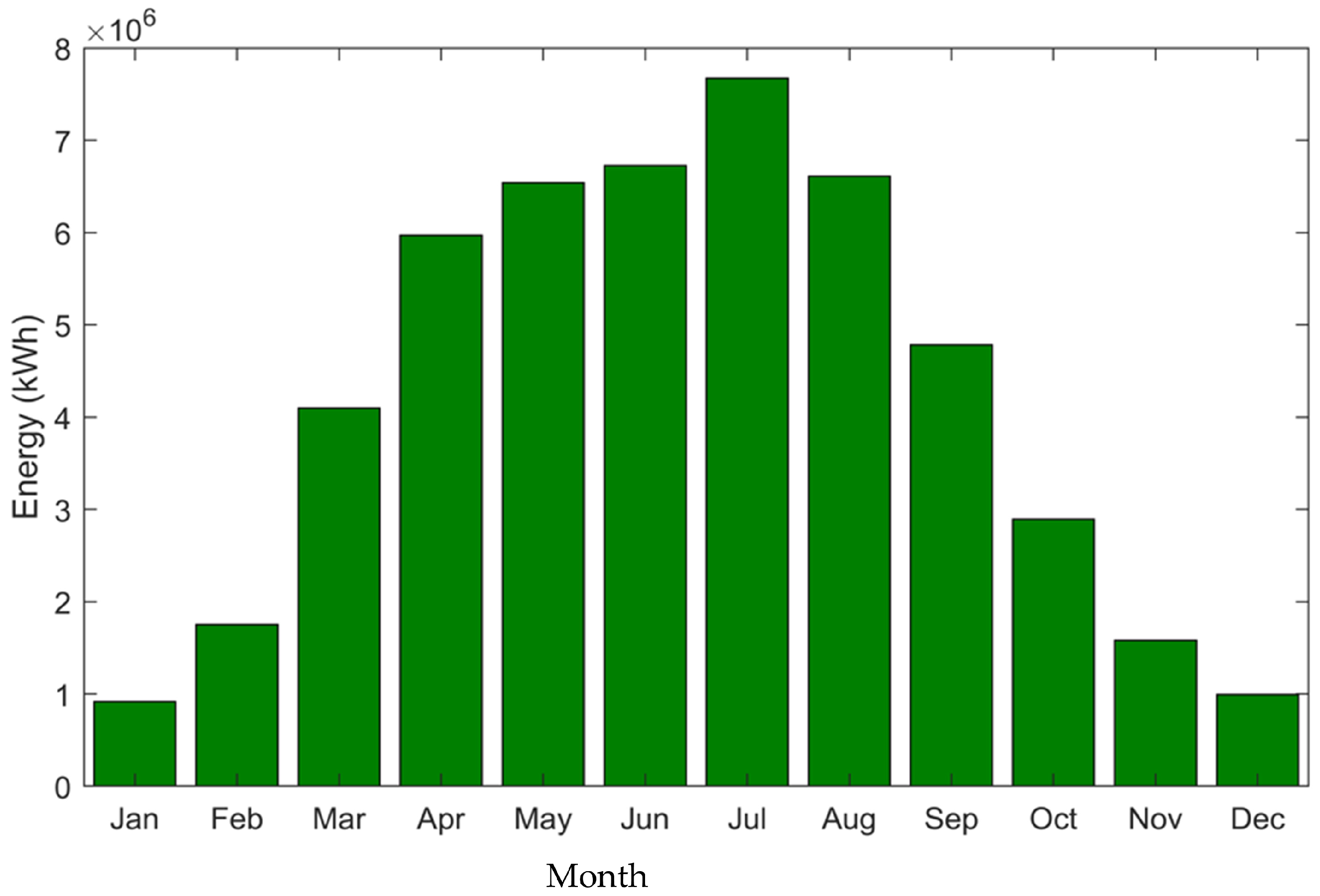




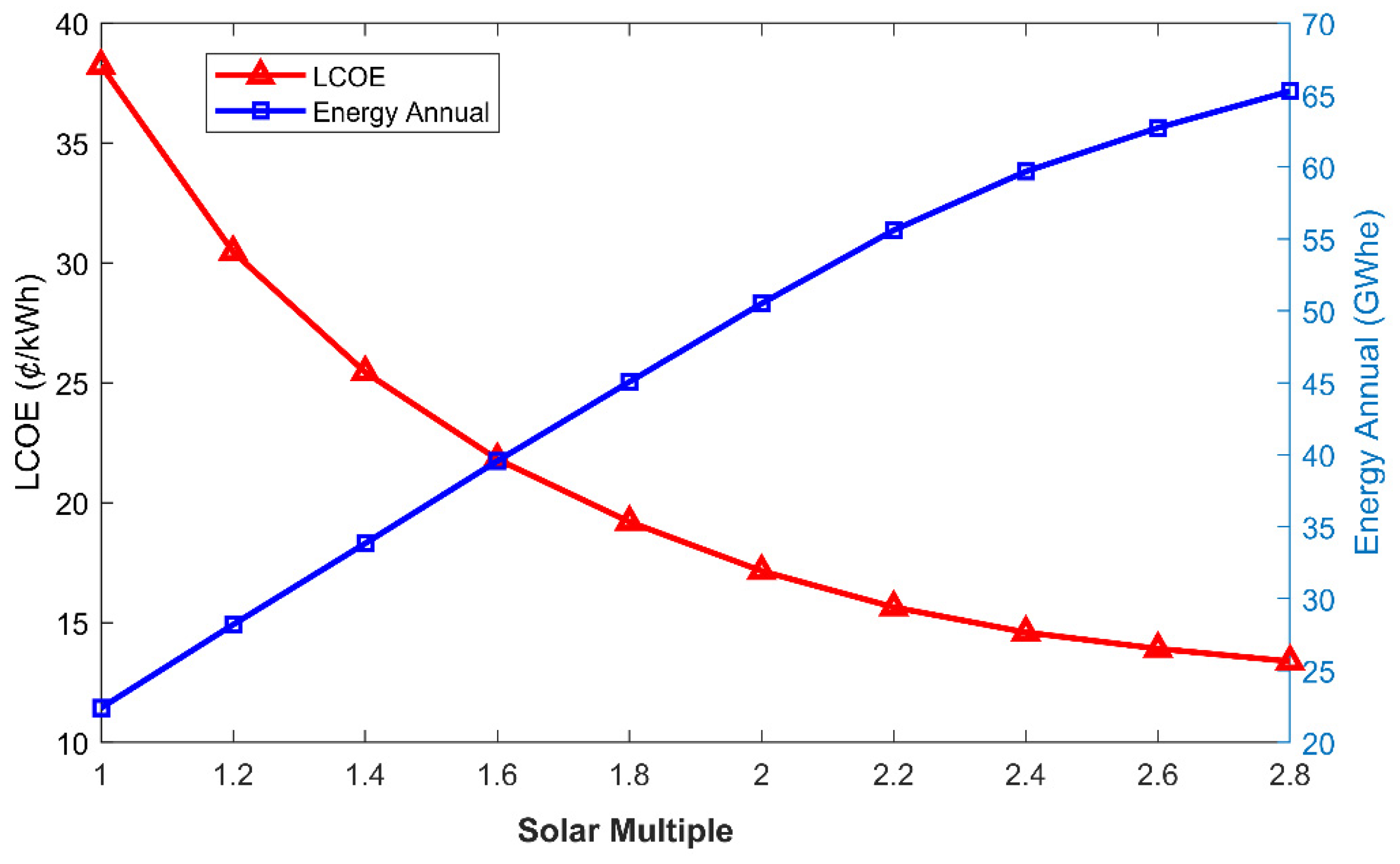
| Site Name | Kenitra |
|---|---|
| Area | |
| Latitude (φ) | |
| Altitude | |
| Longitude | |
| Time zone | UTC+1 |
| Name | Type | Min Operating Temperature (°C) | Max Operating Temperature (°C) | Freeze Point (°C) | Comment |
|---|---|---|---|---|---|
| Therminol VP-1 | Mixture of biphenyl and diphenyl oxide | 12 | 400 | 12 | Standard for current generation oil HTF systems |
| Euro Trough ET 150 Characteristics | ||
| Parameter | Values | Reference and Assumption |
| Focal length | 1.78 | NREL SAM |
| Aperture width, total structure | 5.77 | NREL SAM |
| Reflective aperture area | 817.5 | NREL SAM |
| Absorber radius | 3.5 | NREL SAM |
| Length of collector assembly | 150 | NREL SAM |
| Number of modules per assembly | 12 | NREL SAM |
| Average surface to focus path length | 2.11 | NREL SAM |
| Piping distance between assemblies | 1 | NREL SAM |
| Length of the single module | 12.5 | NREL SAM |
| Number of SCA/HCE assemblies per loop | 4 | Assume |
| Mirror reflectivity | 94 | NREL SAM |
| Schott PTR 70 2008 Receiver Characteristics | ||
| Parameter | Values | Reference |
| Absorber tube inner diameter | 0.066 | NREL SAM |
| Absorber tube outer diameter | 0.07 | NREL SAM |
| Glass envelope inner diameter | 0.115 | NREL SAM |
| Glass envelope outer diameter | 0.12 | NREL SAM |
| Heat loss at design | 147.75 | NREL SAM |
| Parameter | Value | Reference and Assumption |
|---|---|---|
| Plant capacity | ||
| Power cycle gross output | 20 | Assume |
| Estimated gross to net conversion factor | 0.9 | Assume |
| Estimated net output at design (nameplate) | 18 | Assume |
| Power Block design point | ||
| Cycle thermal efficiency | 0.356 | Assume |
| Cycle thermal power | 56.18 | Assume |
| Design inlet temperature | 391 | Assume |
| Design outlet temperature | 293 | Assume |
| General design parameter | ||
| Pumping power for HTF through power block | 0.55 | Assume |
| Fraction of thermal power needed for | 0.2 | |
| standby | ||
| Power block startup time | 0.5 | Assume |
| Fraction of thermal power needed for startup | 0.2 | Assume |
| Maximum turbine over design operation | 1.05 | Assume |
| Minimum turbine operation | 0.2 | Assume |
| Cycle design HTF mass flow rate | 233.5 | NREL SAM |
| Rankine cycle parameters | ||
| Boiler operating pressure | 100 Bar | Assume |
| Steam cycle blowdown fraction | 0.02 | Assume |
| Condenser type | air-cooled | Assume |
| Storage System | ||
| Parameter | Values | Reference and Assumption |
| Hours of thermal energy storage | 6 | Assume |
| Storage volume | 5161.66 | NREL SAM |
| Thermal energy storage thermal capacity | 337.08 | NREL SAM |
| Parallel tank pairs | 1 | Assume |
| Tank height | 20 | Assume |
| Tank fluid minimum height | 1 | Assume |
| Tank diameter | 18.13 | NREL SAM |
| Wetted loss coefficient | 0.4 | Assume |
| Estimated heat loss | 0.365 | NREL SAM |
| Cold tank heater temperature set point | 250 | NREL SAM |
| Hot tank heater temperature set point | 365 | NREL SAM |
| Hot/cold tank heater capacity | 5 | Assume |
| Tank heater efficiency | 0.98 | NREL SAM |
| Hot/cold side HX approach temperature | 5 | NREL SAM |
| Initial thermal energy storage fluid temperature | 300 | NREL SAM |
| Heat transfer fluid density | 1872.49 | NREL SAM |
| Pumping power for heat transfer fluid through storage | 0.15 | Assume |
| Heat transfer fluid (Hitec solar salt) | ||
| Parameter | Values | Reference and Assumption |
| Minimum operating temperature | 238 | NREL SAM |
| Maximum operating temperature | 593 | NREL SAM |
| Freeze point | 238 | NREL SAM |
| Metric | Value |
|---|---|
| Annual AC energy in year 1 | 50,512,084 kWh |
| Annual freeze protection | 5,716,968 kWh |
| Annual TES freeze protection | 84,653 kWh |
| Annual field freeze protection | 5,632,315 kWh |
| Capacity factor | 32.0% |
| Power cycle gross electrical output | 63,278,588 kWh |
| First year kWh/kW | 2806 |
| Gross-to-net conversion | 79.8% |
| Annual water usage | 6547 m3 |
| LCOE levelized cost of energy | 0.1717 $/kWh |
| Financial Model | Value |
|---|---|
| Analysis period | 25 year |
| Inflation rate | 2.5%/year |
| Nominal debt interest rate | 4%/year |
| Nominal construction interest rate | 3.5%/year |
| Project Costs | |
| Nameplate capacity | 18 MW |
| Capital Cost | USD 101,286,000.00 |
| Fixed operating cost | USD 1,188,000 (66 USD⁄(kWh-year)) |
| Variable operating cost | 4 USD⁄MWh |
| Financial Parameters | |
| Fixed charge rate | 7.19% |
| Capital recovery factor | 0.066 |
| Project financing factor | 1.065 |
| Construction financing factor | 1.02 |
| Results | |
| LCOE (FCR Method) | 0.1717 $⁄kWh |
| Authors, Reference | PTSTPP (MWe) | Nets Annual Energy (GWe) | Capacity Factor (%) | Storage Capacity (h) | ) |
|---|---|---|---|---|---|
| This article | 20 | 50.51 | 32 | 6 | 0.1717 |
| Bashir et al. [11] | 80 | 281.145 | 40.1 | 6 | 0.155 |
| Ait Lahoussine Ouali et al. [14] | 50 | 189 | 47.9 | 7.5 | 0.1303 |
| Project NOOR I [31] | 160 | 370 | 26.4 | 3 | 0.28 |
| Project Andasol I [32] | 50 | 158 | 38.1 | 7.5 | 0.23 |
Disclaimer/Publisher’s Note: The statements, opinions and data contained in all publications are solely those of the individual author(s) and contributor(s) and not of MDPI and/or the editor(s). MDPI and/or the editor(s) disclaim responsibility for any injury to people or property resulting from any ideas, methods, instructions or products referred to in the content. |
© 2024 by the authors. Licensee MDPI, Basel, Switzerland. This article is an open access article distributed under the terms and conditions of the Creative Commons Attribution (CC BY) license (https://creativecommons.org/licenses/by/4.0/).
Share and Cite
Naaim, S.; Ouhammou, B.; Aggour, M.; Daouchi, B.; El Mers, E.M.; Mihi, M. Multi-Utility Solar Thermal Systems: Harnessing Parabolic Trough Concentrator Using SAM Software for Diverse Industrial and Residential Applications. Energies 2024, 17, 3685. https://doi.org/10.3390/en17153685
Naaim S, Ouhammou B, Aggour M, Daouchi B, El Mers EM, Mihi M. Multi-Utility Solar Thermal Systems: Harnessing Parabolic Trough Concentrator Using SAM Software for Diverse Industrial and Residential Applications. Energies. 2024; 17(15):3685. https://doi.org/10.3390/en17153685
Chicago/Turabian StyleNaaim, Soufyane, Badr Ouhammou, Mohammed Aggour, Brahim Daouchi, El Mahdi El Mers, and Miriam Mihi. 2024. "Multi-Utility Solar Thermal Systems: Harnessing Parabolic Trough Concentrator Using SAM Software for Diverse Industrial and Residential Applications" Energies 17, no. 15: 3685. https://doi.org/10.3390/en17153685
APA StyleNaaim, S., Ouhammou, B., Aggour, M., Daouchi, B., El Mers, E. M., & Mihi, M. (2024). Multi-Utility Solar Thermal Systems: Harnessing Parabolic Trough Concentrator Using SAM Software for Diverse Industrial and Residential Applications. Energies, 17(15), 3685. https://doi.org/10.3390/en17153685





